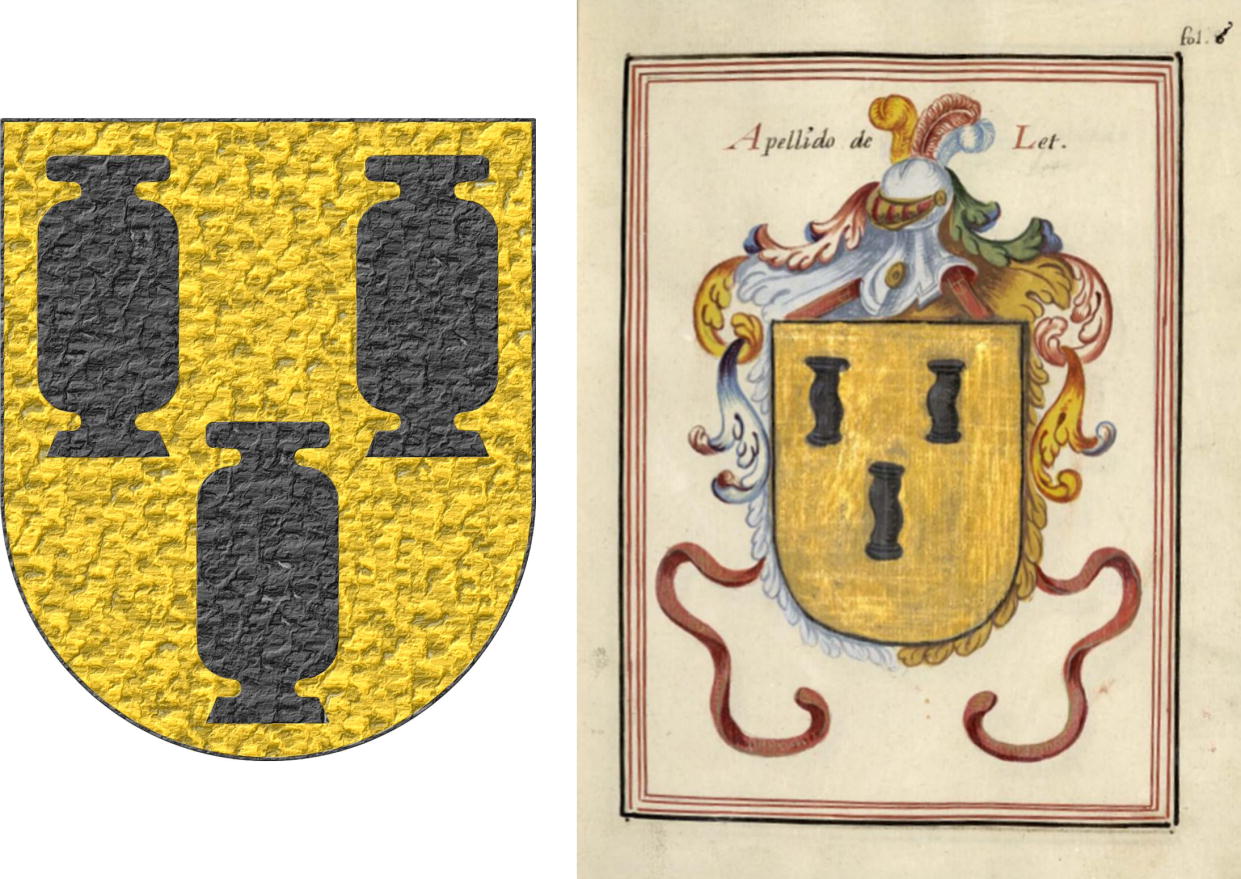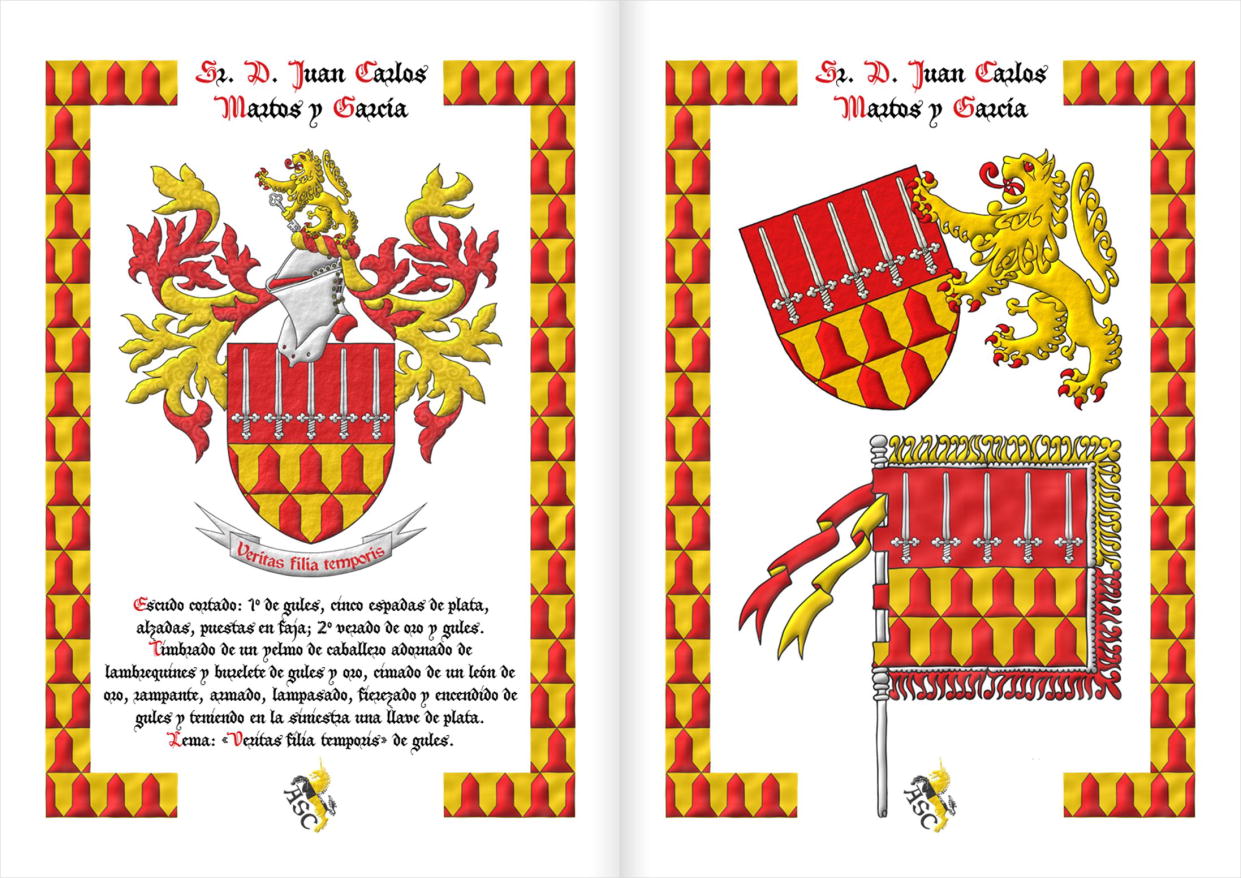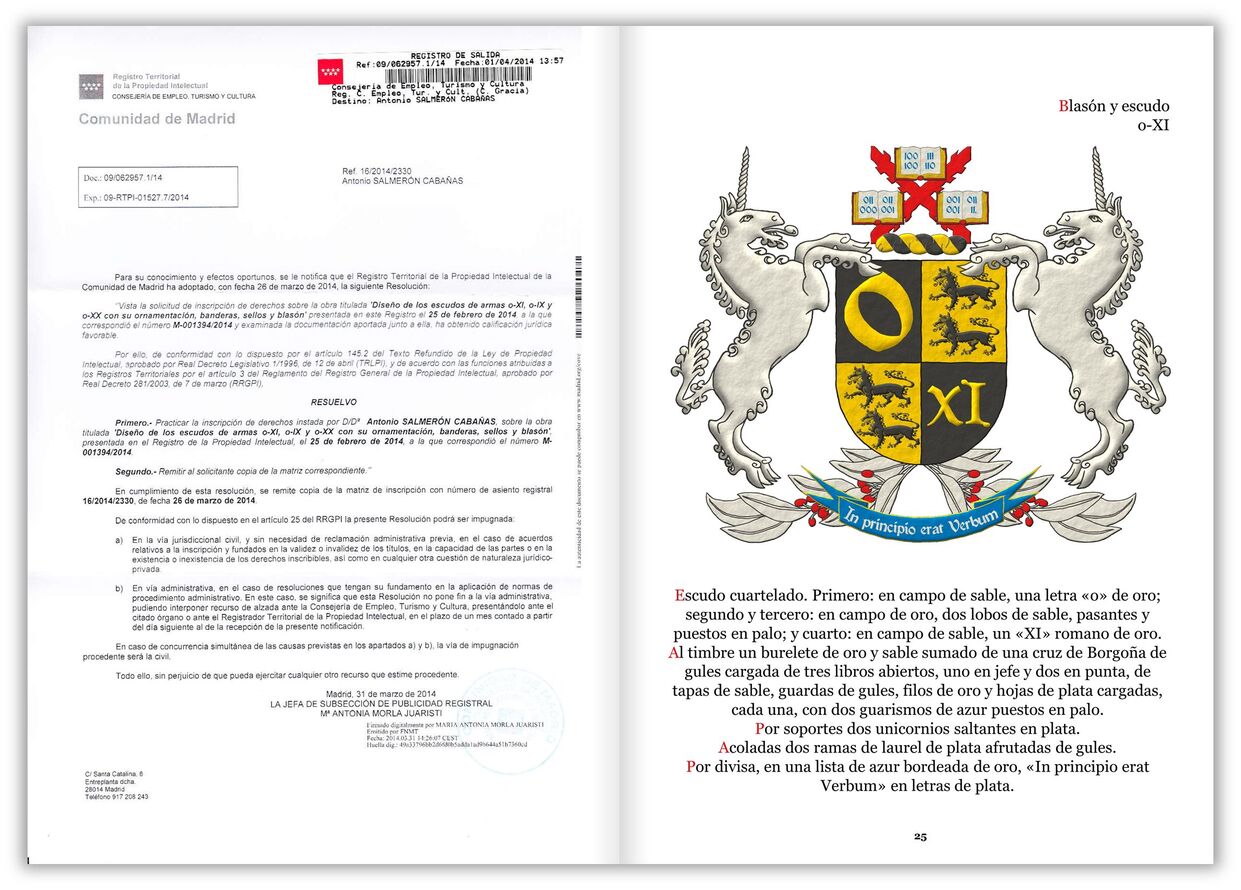
![Ver [Urfé; Siglo XV] en referencias bibliográficas. Libro abierto, hojas de plata, filo de oro, guardas de gules, tapas de sable.](../css/Libro.Bibliografia.png)
Urfé; Siglo XV
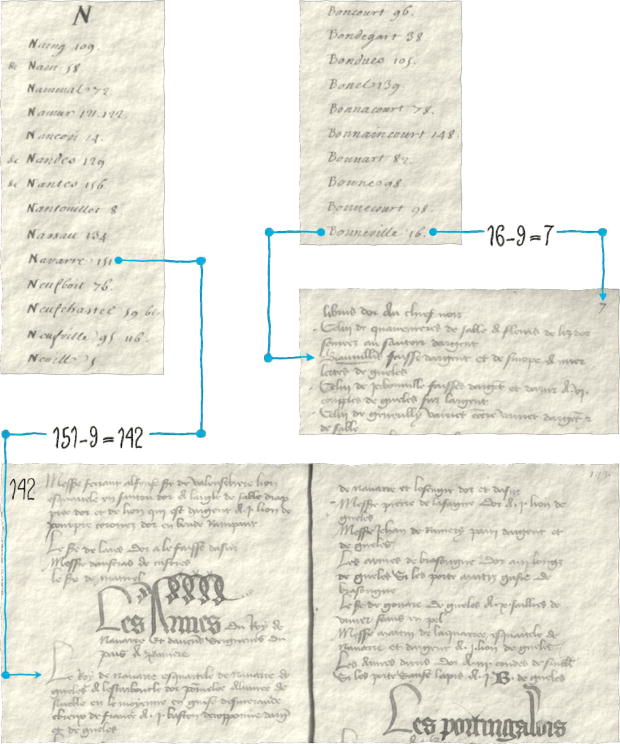
Urfé, unknown authors, «Urfe's Armorial», is currently in National Library of France (BnF, Bibliothèque nationale de France), in Paris, «Cabinet des titres» 927 as indicated on page I, cataloged with the code ms. fr. 32753, it is estimated from the XV century.
This armorial is written in French, on parchment measuring 19.5 x 14 centimeters, its compilation is believed to have been done in the 15th century, it presents 2,855 blazons in written form, but without illustrations, its blazons are organized into 54 sections, with an average of 17 blazons per page, the densest pages with about 20 blazons of 1, 2, or 3 lines per blazon, although some are longer. This Urfé armorial has served as a source for later armorials.
This manuscript contains a preliminary index, written later, of 61 pages, foliated the odd pages in consecutive Roman numerals from folio I to folio XXX. That is, 30 folios of 2 pages plus a final page, totaling 30 x 2 + 1 = 61 pages. This preliminary index consists of a name and a page number where the «theoretically», as will be explained below, corresponding blazon appears.
Next comes the true body of the Urfé armorial, of 162 pages, foliated only the odd pages, dated later than the compilation of the manuscript, in Arabic numerals, 2 by 2, from folio 1 to 161. That is, 1, 3, 5, 7, ..., 159, 161, and the last existing unnumbered page, as it is the 162nd which is even. I say that the 162nd is the last existing page because the National Library of France classifies it as an incomplete manuscript at the end.
It is a bit difficult to understand the relationship between the numbers that appear in the preliminary index, accompanying the names, and the numbering of the pages of the Urfé armorial. For example:
- Bouneville, which in the index appears with the number 16, is blazoned on page 7 (16 - 9 = 7).
- Navarre, for Navarra, in the index appears with the number 151, while the blazon of "Le Roy de Navarre" appears on page 142 (151 - 9 = 142).
This rule of subtracting 9, which has worked for me, but may not be of general use as, for example, Castille~Castile, on page VIII of the index, refers to page 140 of the content and it is there where it is actually found.
The Urfé armorial is in the public domain and the National Library of France, since February 23, 2012, has it published online with identification key ark:/12148/btv1b9063217v.
In this online version, as of today and until corrected, I believe that after page XIX, XVIII and XIX are repeated, just as folio 5 is repeated twice.
Bibliographical reference of century XV.
Classification: Armorial roll, Manuscript, In black and white and French language.
Author: anonymous.
External resources:
- Urfe in Gallica BnF.
- Bouneville indexed in the page 16.
- although it is really on the page 7 (16-9=7).
- Navarra indexed in the page 151.
- although it is really on the page 142 (151-9=142).
- Castilla indexed in the page 140.
- is effectively, in this case, on the same page 140.


![Ver [Vega, P. J. de; 1702] en referencias bibliográficas. Libro abierto, hojas de plata, filo de oro, guardas de gules, tapas de sable.](../css/Libro.Bibliografia.png)
Vega, P. J. de; 1702
Pedro José de Vega, «Compendio de la Maior Parte Ð los Blassones, Armas, e Ynsignias Ð las Ylustres Casas, Familias, y Apellidos del Reyno Ð Navarra i Parte Ð la Provincia de Gvipvzcoa, Segvn las Vsan y Traen los Svccesores Ðellas» ~ «Compendium of the Greater Part of the Blazons, Arms, and Insignias of the Illustrious Houses, Families, and Surnames of the Kingdom of Navarre and Part of the Province of Guipuzcoa, As Used and Carried by Their Successors», manuscript in 2 volumes, Volume I, catalog number MSS/7835 V.1, and Volume II, catalog number MSS/7836 V.2, in the National Library of Spain, 1702.
As stated on the title page, the Field Master «Pedro Ioseph Ð Vega» was a native of the Kingdom of Navarre, deputy of the Kingdom of Navarre from 1688 to 1691, governor of the provinces of Cotabamba and Parinacochas in Peru, written as «governador», and gentleman of the «Voca de su Majestad» (His Majesty's Voice).
Bibliographical reference of century XVIII.
The author is Vega, Pedro José de.
External resource:


![Ver [Registro Internacional de Armas Gentilicias] en instituciones citadas. Fortaleza de oro y mazonada de sable.](../css/Fortaleza.Institucion.png)
Registro Internacional de Armas Gentilicias
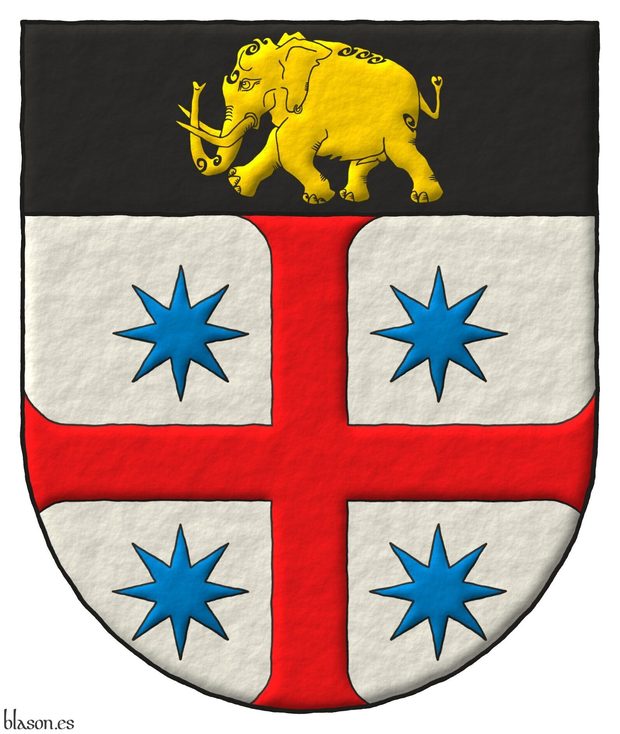
RIAG
Argent, a cross patty Gules, cantoned of four mullets of eight points Azure; on a chief Sable, an elephant passant Or.
The Registro Internacional de Armas Gentilicias, is also known as RIAG, and riag.com.es is it domain.
It is a private register of coat of arms founded in 2006 in Seville, Spain by the herald Ignacio Koblischek Zaragoza.
Categories: Institution, Socioeconomic, Semi-circular, Illuminated, Outlined in sable, Outlined in the field tincture, Freehand, Argent, Diminished cross, Patty, Gules, Cantoned, Mullet, Eight, Azure, Chief, Sable, Elephant, Passant and Or.


Completion and fulfillment, a phase with three activities
Heraldic edition:
- Its objective is the definitive edition of the blazon and its explanatory texts illustrated with images of the coat of arms, accompanied by the heraldic objects that complement it and adorned with a specific framework tailored to each registrant.
- Its outcome is a catalog of delivery of the heraldic work stamped, signed, dated and numbered.
Final review and delivery:
- Its goal is a last review of the complete work and to perform the latest appropriate corrections.
- The result is the delivery of the work to its holder, point where the heraldic process end.
Documentation and closure of records:
- Its goal is to finish the internal documentation of the work and the final archival of both the intermediate material and the final result.
- The result is a new record, keyed on the numbering of the heraldic catalog, in a documentary and graphic content management file.


![Ver [Salmerón Cabañas, A.; 2014a] en referencias bibliográficas. Libro abierto, hojas de plata, filo de oro, guardas de gules, tapas de sable.](../css/Libro.Bibliografia.png)
Salmerón Cabañas, A.; 2014a
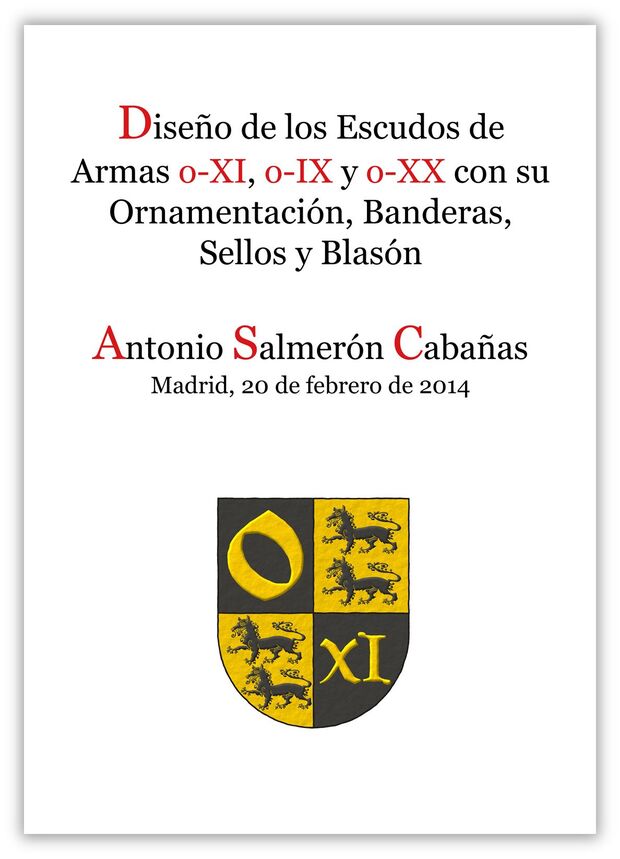
Antonio Salmerón Cabañas, «Design of the coats of arms o-XI, o-IX, o-XX with their crest, supporters, flags, seals and blazons», paintings registered in the Intellectual Property Registry of Madrid, 28 pages with 47 illustrations, of coats of arms and other heraldic objects, request code M-1394-14, and registration number 16/2014/2330, Madrid, 25th of February of 2014.
In this registration are the illustrations from my book [Salmerón Cabañas, A.; 2014b] titled «The Book of the Coat of Arms of Wolves Sable and Unicorns Argent».
Bibliographical reference of century XXI.
The author is Salmerón Cabañas, Antonio.
Bibliographical reference mentioned in the following article:


![Ver [Valero de Bernabé, L.; 2014] en referencias bibliográficas. Libro abierto, hojas de plata, filo de oro, guardas de gules, tapas de sable.](../css/Libro.Bibliografia.png)
Valero de Bernabé, L.; 2014
Luis Valero de Bernabé y Martín de Eugenio, «El Bestiario Heráldico Balear», 48 pages, estimated publication date 16th of September of 2014.
It consists of an introduction and a series of chapters that deal with terrestrial animals, native wild animals, exotic animals, domestic animals, aerial animals, aquatic animals, and fantastic animals.
I only have the work in a digital PDF format and I do not know if it has been published in any other medium or format.
Bibliographical reference of century XXI.
Author: Valero de Bernabé y Martín de Eugenio, Luis.
Internal resources: ValeroBernabeL2014.BestiarioHeraldicoBalear.pdf.


![Ver [Valero de Bernabé, L.; Márquez de la Plata, V. M.; 2003] en referencias bibliográficas. Libro abierto, hojas de plata, filo de oro, guardas de gules, tapas de sable.](../css/Libro.Bibliografia.png)
Valero de Bernabé, L.; Márquez de la Plata, V. M.; 2003
Luis Valero de Bernabé y Martín de Eugenio, with the collaboration of Vicenta María Márquez de la Plata, «Simbología y diseño de la heráldica gentilicia galaica», 574 pages, editado por Ediciones Hidalguía, printed by Gráficas Arias Montano SA, Móstoles, Legal Deposit M. 7.135-2003, ISBN 84-89851-43-3, Madrid, 1st of January of 2003.
It consists of an introduction and 5 chapters that deal with the field and tinctures of the coat of arms, the honorable pieces, heraldic furniture, natural figures, figures related to man and human activity, and then delves into the family heraldry of lineages from the Kingdom of Galicia or settled in Galicia.
Bibliographical reference of century XXI.
Authors: Valero de Bernabé y Martín de Eugenio, Luis and Márquez de la Plata, Vicenta María.
External link:

Sigue por: Adams, A.; 1941.
-
Language
-
Categories of heraldry
-
Divisions of the field
- Without divisions
- Party per pale
- Party per fess
- Party per bend sinister
- Tierce
- Tierce sinister
- Tierced per bend
- Quarterly
- Quarterly per saltire
- Gyronny
- Party per fess, the chief per pale
- Party per pale, the sinister per fess
- Party per fess, the base per pale
- Party per pale, the dexter per fess
- Party per chevron
- Indented
- Enté en point
- Flanched
-
Metals
-
Colours
-
Furs
-
Other tinctures
-
Ordinaries and sub-ordinaries
-
Diminutives of the ordinaries
-
Other charges
-
Charges from Nature
Eagle, Two hands clasped, Lark, Tree, Rainbow, Trunk of a tree, Atom, Barbel, Acorn, Arm, Owl, Horse, Head, Thistle, Stag, Doe, Crescent, Increscent, Tail, Heart, Roe deer, Neck, Roe deers' attires, Raven, Dolphin, Diamond, Tooth, Elephant, Emerald, Starling, Mullet, Estoile, Male figure, Fleur de lis, Hop cone, Puffin, Ash, Paw, Goose, Seagull, Pomegranate, Sunflower, Falcon, Leaf, Flame, Boar, Barn owl, Lion, Lioness, Lion passant, Leopard, Lion rampant guardant, Lynx, Lily, Wolf, Hand, Apple, Martlet, Wing, Two wings in vol, Covert, Mount, Trimount, Wrist, Orbital, Bear, Palm tree, Poplar leaf, Paw, Peacock, Chest, Dog, Brach hound, Fish, Hoof, Quill, Cinquefoil, Quetzal, Branch, Oak, Rose, Double rose, Serpent, Sun in splendour, Ray of the sun, Stem, Wheat, Wheat spike, Bull, Tulip, Udder, Escallop and Fox.
-
Artificial charges
Halberd, Plough share, Ace of spades, Cyclamor, Torch, Harp, Non-classic artifact, Crozier, Ship, Beret, Grenade, Ecclesiastical cap, Chain, Covered cup, Bell tower, Cannon dismounted, Carbuncle, Castle, Clarion, Nail, Cord, Dagger, Key ward, Turret, With a turret, Sword, Sabre, Scroll, Arrow, Garb, Gauntlet, Buckle, Spear, Spear's head, Letter, Book, Line, Key, Four crescents joined millsailwise, Hammer, Menorah, Number, Knot, Celtic Trinity knot, Parchment, Piano, Millstone, Millrind, Millwheel, Clay pot, Bridge, Hourglass, Chess rooks, Compass rose, Rosette of acanthus leaves, Mullet of six points pierced, Portcullis, Wheel, Wagon-wheel, Symbol, Sackbut, Drum, Tower, Trident, Double vajra and Anvil.
-
Immaterial charges
Angel, Heart enflamed, Sacred Heart of Jesus, Paschal lamb, Dragon, Phoenix, Griffin, Winged hand, Pegasus, Saint George, Trinity, Triton, Golden fleece and Unicorn.
-
External elements
-
Heraldic creations
-
References
-
Formats
-
Keywords on this page
Armorial roll, Artist, Azure, Bibliography, Cantoned, Cheshire County, Outlined in sable, Outlined in the field tincture, Doctor, Elephant, In black and white, Diminished cross, Mullet, Gules, Illuminated, Institution, Chief, French language, Manuscript, Martlet, Semi-circular, Eight, Or, Canting, Passant, Patty, Argent, Without divisions, Clay pot, Intellectual property, Registro Internacional de Armas Gentilicias, Kingdom of Navarre, Sable, Century XV, Century XVIII, Century XX, Century XXI, Socioeconomic, Party per bend sinister and Freehand.
